

WCF Tutorial - Hosting. D:\PW\przedmioty\PwSW2\Tutorials\wcf\3.5\Advanced\Third\WindowsServiceNamedPipeHost\bin\Debug>installutil WindowsServiceNamedPipeHost.exeMicrosoft (R) .NET Framework Installation utility Version 2.0.50727.3053Copyright (c) Microsoft Corporation.
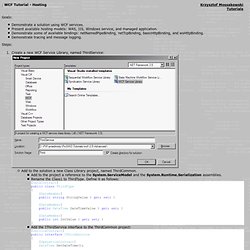
All rights reserved. Running a transacted installation. The Commit phase completed successfully. The transacted install has completed. D:\PW\przedmioty\PwSW2\Tutorials\wcf\3.5\Advanced\Third\WindowsServiceNamedPipeHost\bin\Debug> MVVM Light Toolkit. Introduction The main purpose of the toolkit is to accelerate the creation and development of MVVM applications in WPF, Silverlight, Windows Store (RT) and for Windows Phone.
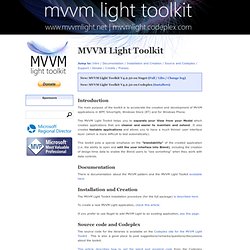
The MVVM Light Toolkit helps you to separate your View from your Model which creates applications that are cleaner and easier to maintain and extend. It also creates testable applications and allows you to have a much thinner user interface layer (which is more difficult to test automatically). This toolkit puts a special emphasis on the "blendability" of the created application (i.e. the ability to open and edit the user interface into Blend), including the creation of design-time data to enable the Blend users to "see something" when they work with data controls. Documentation. Utilisez le pattern Model-View-ViewModel dans vos applications Silverlight grâce à MVVM Light toolkit. Pour illustrer l'utilisation du toolkit, je vais m'attacher à transformer le projet qui est généré lors de la création d'un nouveau projet de type Silverlight Navigation Application pour qu'il respecte le pattern M-V-VM.

Certes, l'application créée n'est pas très aboutie. Maintenant, transformons celle-ci pour qu'elle respecte le pattern M-V-VM, et pour ce faire, on va utiliser le MVVM Light Toolkit de Laurent Bugnion. 3.2.1.Installer MVVM Toolkit▲ L'installation est très simple, rendez vous sur la page dédiée. [C#] Comprendre les expressions lambda de C# 3 , Thomas Lebrun. [C#] Comprendre les expressions lambda de C# 3 Avec l'arrivée de C# 3, on voit ce langage s'enrichir de nouvelles fonctionnalités L'une d'entre elles s'appelle les expressions lambda: derrière ce terme un peu barbare se cache un concept puissant que je vais tâcher de vous résumer en quelques lignes.
![[C#] Comprendre les expressions lambda de C# 3 , Thomas Lebrun](http://cdn.pearltrees.com/s/pic/th/comprendre-expressions-lambda-38997397)
Avant de rentrer dans le vif du sujet, il faut se rappeler d'une des fonctionnalités offerte par C# 2: les méthodes anonymes. Ces méthodes permettaient aux développeurs d’écrire des blocs de code en ligne, lorsque des délégués étaient nécessaires. Par exemple, on pouvait tout à fait écrire quelque chose comme ceci : List<int> list = new List<int>(new int [] { -1, 2, -5, 45, 5 }); Comprendre le Binding en WPF et Silverlight. Avec l'arrivée de WPF et Silverlight, on a vu apparaître le XAML, nouvel élément pour construire des interfaces graphiques riches dans le monde de .Net. ItemsControl: A to Z « Dr. WPF. How SelectedValue and DisplayMemberPath saved my life. Download SampleWPF - 31.42 KB Introduction First excuse my English, i'm a little out of practice.

A few days ago i was to write user control using WPF (which was 'terra incognita' for me) and i would gladly give a half of kingdom for an article i'm trying to write that time. Well...i hope it will be as useful as intended to be. Méthodologie MVVM avec WPF. Dans cet article, je présente une méthodologie, appelée MVVM pour Modèle-Vue-VueModèle.

MVVM permet de tirer partie des bénéfices de la plateforme WPF tout en conservant une application correctement architecturée, maintenable et testable. Vous remarquerez que tout au long de l'article, j'utilise plus le terme méthodologie que design pattern pour parler de MVVM. ICollectionView for MVVM. Lately I have been getting a lot of questions on ICollectionView so I decided to write a very small post on how it works and some tips and tricks you might find useful when using it.

ICollectionViews are used for filtering, sorting, grouping and also selecting items in list controls (selecting applies only for controls that inherit from the Selector base class such as ListBox, ComboBox etc..). This is the MSDN documentation description of a ICollectionView : “You can think of a collection view as a layer on top of a binding source collection that allows you to navigate and display the collection based on sort, filter, and group queries, all without having to manipulate the underlying source collection itself” And yes I agree, it is a very powerful mechanism and helps a lot when you are separating “concerns” by using patterns such as M-V-VM.
TreeView MVVM. Download the source code (requires Visual Studio 2008) - 28.6 KB Introduction This article explores how to use the ViewModel pattern to make it easier to work with the TreeView control in WPF.
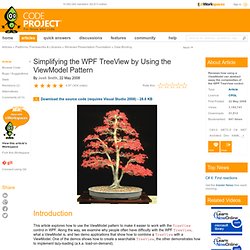
MVVM Creating an Internationalized Wizard in WPF. Table of Contents Introduction This article reviews a WPF application that contains a Wizard-style user interface.
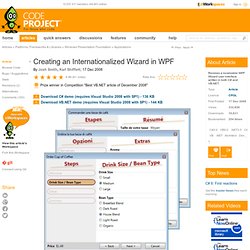
It explains how the application was globalized, so that it can run in various cultures and show its display text in any language. The application uses the Model-View-ViewModel (MVVM) design pattern as its core architecture. Windows Presentation Foundation. Syntaxe XAML en détail. Dependency Properties. Gestion des ressources. .NET 3.0 : Comprendre les dependency properties et les propriétés attachées , Code is poetry. WPF : Comprendre les Routed Events , Code is poetry. WPF : Comprendre les Routed Events WPF n’utilise pas le mécanisme standard d’évènement du Framework .NET.
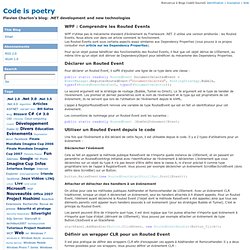
Il utilise une version améliorée : les Routed Events. Nous allons voir dans cet article comment ils fonctionnent.Les Routed Events sont sous certains aspects assez similaires aux Dependency Properties (vous pouvez à ce propos consulter mon article sur les Dependency Properties). Pour qu’un objet puisse bénéficier des fonctionnalités des Routed Events, il faut que cet objet dérive de UIElement, au même titre qu’un objet doit dériver de DependencyObject pour bénéficier du mécanisme des Dependency Properties.